| Pages:
1
..
11
12
13
14 |
not_important
International Hazard
    
Posts: 3873
Registered: 21-7-2006
Member Is Offline
Mood: No Mood
|
|
| Quote: | Originally posted by hector2000
I am Wonder How Acetyle chloride React With Steel(318) wheras Pure Nitric Acid Cant.!  |
Strong nitric acid, an oxidising agent, forms a passivated layer on the surface of the metal.
Acetyl chloride is not an oxidising agent, but will form HCl from traces of moisture; both HCl and soluble chlorides are notoriously corrosive to
ferrous alloys.
|
|
|
hector2000
Hazard to Others
  
Posts: 127
Registered: 22-8-2006
Member Is Offline
Mood: Cool
|
|
THEREFORE We Cant Use Steel Container?
This Is Possible That We Use of Steel with coat of Gold or platinum or nickel?
May Acetyle Chloride React With them?
What is Your Suggestion?
[Edited on 31-3-2008 by hector2000]
Chemistry=Chem+ is+ Try
|
|
|
hector2000
Hazard to Others
  
Posts: 127
Registered: 22-8-2006
Member Is Offline
Mood: Cool
|
|
Anybody has idea about steel 321?
This type of steel is very RESISTANT for acids.
Chemistry=Chem+ is+ Try
|
|
|
S.C. Wack
bibliomaster
    
Posts: 2419
Registered: 7-5-2004
Location: Cornworld, Central USA
Member Is Offline
Mood: Enhanced
|
|
And eventually...the original article on acetic anhydride from ketene.
[Edited on 2-9-2008 by S.C. Wack]
Attachment: jacs_54_3427_1932.pdf (351kB)
This file has been downloaded 1348 times
|
|
|
einstein(not)
Hazard to Self
 
Posts: 50
Registered: 14-12-2006
Member Is Offline
Mood: No Mood
|
|
Sorry in adavance if I've missed the answer to my question. Can copper be used in a tube furnace for ketene? I'm asking because of this http://jchemed.chem.wisc.edu/JCEsoft/CCA/CCA5/MAIN/1ORGANIC/...
|
|
|
Fleaker
International Hazard
    
Posts: 1252
Registered: 19-6-2005
Member Is Offline
Mood: nucleophilic
|
|
Copper can be used.
See this thread with pictures where I did it.
https://www.sciencemadness.org/whisper/viewthread.php?tid=74...
We have some FTIR scans of the gas cell kicking around...somewhere. It does work, and it would probably work half decent if you had a very large tube
to do it--perhaps liters per day.
Make sure you don't make an ass of yourself by not closing your tube up properly as I can assure you it is flammable and smells something awful. 
This is an experiment I really want to repeat sometime.
Neither flask nor beaker.
"Kid, you don't even know just what you don't know. "
--The Dark Lord Sauron
|
|
|
TIETSE
Hazard to Self
 
Posts: 53
Registered: 21-8-2008
Member Is Offline
Mood: No Mood
|
|
you can use stainless steel 304, because if you gonna make a pipe bomb is teh best stainless steel to welding and for more info look the link below

http://en.wikipedia.org/wiki/Stainless_steel
|
|
|
not_important
International Hazard
    
Posts: 3873
Registered: 21-7-2006
Member Is Offline
Mood: No Mood
|
|
You can use stainless steel, but most of the research papers report low to zero yields of ketene when using ferrous tubing; from experience ferrous
alloys do seem to catalyse cracking to carbon while copper does not do so.
|
|
|
Magpie
lab constructor
    
Posts: 5939
Registered: 1-11-2003
Location: USA
Member Is Offline
Mood: Chemistry: the subtle science.
|
|
I want to congratulate Praxichys on his construction of an ingeniously simple ketene lamp and successful synthesis of acetic anhydride using this
lamp. This can be seen at Doug's Lab on YouTube.
The single most important condition for a successful synthesis is good mixing - Nicodem
|
|
|
hector2000
Hazard to Others
  
Posts: 127
Registered: 22-8-2006
Member Is Offline
Mood: Cool
|
|
finally good news after 8 years.
respect for all people who share information on this topic.
especial thanks to @Sauron,@Nicodem,@not_important and @Praxichys for movie on youtube.
[Edited on 31-12-2015 by hector2000]
Chemistry=Chem+ is+ Try
|
|
|
Waffles SS
Fighter
   
Posts: 998
Registered: 7-12-2009
Member Is Offline
|
|
My old Facilities for making Keten by Furnace (6 years ago):
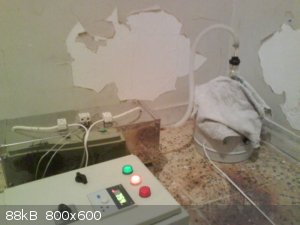
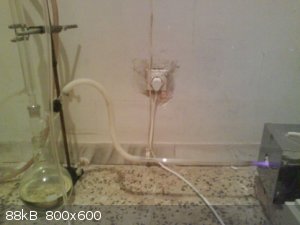
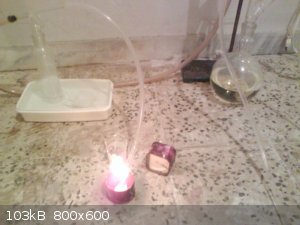
And now by keten lamp(in my lab):
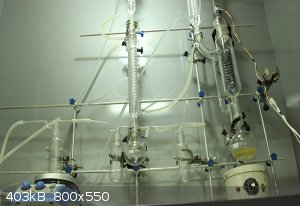
[Edited on 4-1-2016 by Waffles SS]
|
|
|
Praxichys
International Hazard
    
Posts: 1063
Registered: 31-7-2013
Location: Detroit, Michigan, USA
Member Is Offline
Mood: Coprecipitated
|
|
@ Magpie: Thank you! I'm working on an article for prepublication to commit it to the annals of SM.
@ Waffles: Wow, that is a proper ketene lamp. What are you using for the heating element? I like how you used a schlenk flask with a septum
for the acetone reservoir, probably so you can inject more acetone while it's running? Very nice!
|
|
|
Waffles SS
Fighter
   
Posts: 998
Registered: 7-12-2009
Member Is Offline
|
|
Thanks Praxichys,
I used 2.5mm diameter Ni/Cr wire and i built this system according to Vogel Keten lab instruction.(Vol.3,p372-373)
[Edited on 5-1-2016 by Waffles SS]
|
|
|
NZniceguy
Harmless

Posts: 48
Registered: 16-9-2017
Member Is Offline
Mood: No Mood
|
|
Can anyone tell me what to do if I was to be using a ketene lamp setup identical to Praxichys video on youtube and finding it hard to get the sweet
spot between no ketene being made and white smoke filling the rbf trap for byproducts etc and going through to the gaa absorbtion tube. I assume this
smoke is not good but cant seem to find a voltage setting that will produce enough bubbles to do anything but not create this white smoke.
Any ideas? I had it running for 3 hours the other day and only ended up with approx 10 mls of product after fractionating.
|
|
|
NZniceguy
Harmless

Posts: 48
Registered: 16-9-2017
Member Is Offline
Mood: No Mood
|
|
New lamp
Well I went to fire it up again and have noticed a crack starting at the bottom of the chratography reservoir.......the wire element was too close to
the glass and thermal expansion etc.....so I was stuck until another arrives in a week or two until I looked over at a friedrichs condenser that
arrived with the inner finger broken off by customs (arseholes!).....I figured if I could hollow out all the inner workings then I could feed the two
wires for the coil down the old water nipples and epoxy the holes shut.....can always pick it out if need be. I'll attach some pics but unfortunately
you cant see through the glass very well as it got etched as I hollowed out the inner workings. What do you think?
[Edited on 2-11-2017 by NZniceguy]
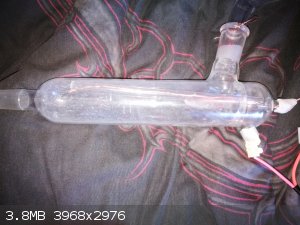 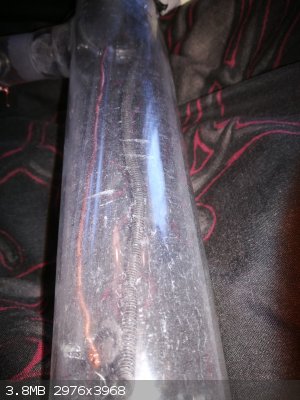
|
|
|
Fulmen
International Hazard
    
Posts: 1693
Registered: 24-9-2005
Member Is Offline
Mood: Bored
|
|
Looks promising. What about a glass wool lining to protect the tube from the hot filament?
Glass certainly has it's problems dealing with high temperatures. I've been thinking about constructing an all-metal reactor lately to avoid such
problems entirely. The thought of ketene and acetone vapor in the case of a failure isn't all that inviting.
One thing confuses me though. In a document I found (564 Schmidlin Ketene Synthesis, can't remember from where) they claim "this reaction cannot be
conducted through a metal tube, either a copper tube or an iron pipe because carbon may form via dehydrogenation in the presence of some metal
oxides." Yet the standard ketene lamp uses hot metal wire. Or is this avoidable by careful temperature control?
Except for the hot zone most metals should be compatible, right?
We're not banging rocks together here. We know how to put a man back together.
|
|
|
hissingnoise
International Hazard
    
Posts: 3940
Registered: 26-12-2002
Member Is Offline
Mood: Pulverulescent!
|
|
| Quote: | | In a document I found (564 Schmidlin Ketene Synthesis, can't remember from where) they claim "this reaction cannot be conducted through a metal tube,
either a copper tube or an iron pipe because carbon may form via dehydrogenation in the presence of some metal oxides |
The glass in this set-up can be replaced by 430 SS tubing ─ copper, too, will work but won't last as long due to slow oxidation at high temp..
|
|
|
NZniceguy
Harmless

Posts: 48
Registered: 16-9-2017
Member Is Offline
Mood: No Mood
|
|
If even some of the acetone vapour made it through and ended up condensing into the end mixture, wouldnt it then dissolve the ketene (with ketene
being soluble in acetone) therefore preventing full conversion of the acetic acid?
|
|
|
hissingnoise
International Hazard
    
Posts: 3940
Registered: 26-12-2002
Member Is Offline
Mood: Pulverulescent!
|
|
Indeed, an efficient condenser is required in any case.
|
|
|
sykronizer
Harmless

Posts: 14
Registered: 16-12-2017
Member Is Offline
Mood: omnivorous
|
|
NZniceguy.....you've got far too much wire coiled up in there...odds are that you are over cooking everything...you want a dull red heat, that is, in
a dimly lit room you can barely just see a deep red glow coming off that wire...have you got a infra red type thermometer ? I'm not sure how accurate
those are, but it might help you get the temp dialed in. I had a similar problem to this in another pyrolytic process, and I was getting this white
mist condensate..long story short too high on the temp....You might want to rip out that coil and try using only like a quarter of that amount of
wire, the whole thing is just over kill...trust me on this...my fellow kiwi...
|
|
|
Magpie
lab constructor
    
Posts: 5939
Registered: 1-11-2003
Location: USA
Member Is Offline
Mood: Chemistry: the subtle science.
|
|
Quote: Originally posted by sykronizer  | | NZniceguy.....you've got far too much wire coiled up in there...odds are that you are over cooking everything...you want a dull red heat, that is, in
a dimly lit room you can barely just see a deep red glow coming off that wire...have you got a infra red type thermometer ? I'm not sure how accurate
those are, but it might help you get the temp dialed in. I had a similar problem to this in another pyrolytic process, and I was getting this white
mist condensate..long story short too high on the temp....You might want to rip out that coil and try using only like a quarter of that amount of
wire, the whole thing is just over kill...trust me on this...my fellow kiwi... |
Be careful...if you take out wire without lowering the voltage you will actually increase the temperature. For a wonderful ketene lamp see Doug's Lab
YouTube video.
The single most important condition for a successful synthesis is good mixing - Nicodem
|
|
|
NZniceguy
Harmless

Posts: 48
Registered: 16-9-2017
Member Is Offline
Mood: No Mood
|
|
Quote: Originally posted by sykronizer  | | NZniceguy.....you've got far too much wire coiled up in there...odds are that you are over cooking everything...you want a dull red heat, that is, in
a dimly lit room you can barely just see a deep red glow coming off that wire...have you got a infra red type thermometer ? I'm not sure how accurate
those are, but it might help you get the temp dialed in. I had a similar problem to this in another pyrolytic process, and I was getting this white
mist condensate..long story short too high on the temp....You might want to rip out that coil and try using only like a quarter of that amount of
wire, the whole thing is just over kill...trust me on this...my fellow kiwi... |
Thanks for that info, that lamp ended up cracking after the 2nd use so I went back to the 250ml chromatography reservoir ala the Dougs Lab video but
maybe I still have too much heat as its still not dialed in quite right...I also tried putting the acetone/byproducts trap in an icebath to try stop
any acetone coming over into the G.A.A. I havnt tried it in a week or so but must try again sometime soon..........the voltage doesnt matter as im
running it on a motor speed controller and just crank it up till I get bubbles coming through the g.a.a. but it does seem like the element is redder
than in the video and as you describe but any lower and i lose the bubbles/ketene (checked for leaks also).......Ive tried an infra red thermometer
but it doesnt seem to work through the glass damnit!
|
|
|
nleslie321
Hazard to Self
 
Posts: 62
Registered: 7-11-2017
Location: krakatoa
Member Is Offline
Mood: just right
|
|
NZniceguy i have successfully used a boiling flask with claisen with a coil that reaches close to the bottom of the straight arm with a condenser in
the bent arm then male/male u shape adaptor then another condensor then 2 neck round bottom with tube coming from second neck to another round bottom
with GAA very similar to Vogals and Dougs setup. I have used this many times without any cracks in the claisen adaptor. i did break a few from too
high temp when first trying. i use a variac at about 42 volts with a thick 23 gauge nichrome wire ive never had any carbon buildup like when i was
using the thinner nichrome. if your heating it enough to crack the glass its way to hot. if you do it in day light you shouldnt hardly see anything
more than a dark red tinge to the wire. also make sure to grease all joints as if you dont u will be getting leaks even if you think your not. once
you grease joints you will get the pressure required to bubble the gas through the GAA at the right temperature. Any hotter you will get it bubbling
through but will not get any product as there is no ketene making it to the flask. Also the bigger the coil you use the more gas pressure youll get at
the same temperature so if you find at the right heat you still cant produce enough pressure try a bigger coil or thicker gauge wire = more surface
area. Also in saying that in a regular 24/40 claisen adaptor i fit my coil and have no trouble bubbling ketene at a very fast rate.
Hope this helps you.
|
|
|
wg48
National Hazard
   
Posts: 821
Registered: 21-11-2015
Member Is Offline
Mood: No Mood
|
|
Quote: Originally posted by NZniceguy  |
Thanks for that info, that lamp ended up cracking after the 2nd use so I went back to the 250ml chromatography reservoir ala the Dougs Lab video but
maybe I still have too much heat as its still not dialed in quite right...I also tried putting the acetone/byproducts trap in an icebath to try stop
any acetone coming over into the G.A.A. I havnt tried it in a week or so but must try again sometime soon..........the voltage doesnt matter as im
running it on a motor speed controller and just crank it up till I get bubbles coming through the g.a.a. but it does seem like the element is redder
than in the video and as you describe but any lower and i lose the bubbles/ketene (checked for leaks also).......Ive tried an infra red thermometer
but it doesnt seem to work through the glass damnit! |
The colour and brightness of glowing elements tends to be incorrect on images and video. I suggest you use the eye ball method suggested by the
previous poster. But if you lower the temperature and get no bubbles I guess you must have it about correct or you have an other problem.
Borosilicate glass:
Good temperature resistance and good thermal shock resistance but finite.
For normal, standard service typically 200-230°C, for short-term (minutes) service max 400°C
Maximum thermal shock resistance is 160°C
|
|
|
Hunterman2244
Hazard to Others
  
Posts: 105
Registered: 6-6-2018
Member Is Offline
|
|
Besides Ac2O, ketene has a lot of potential. For example, making acetophenone (from toluene?). Using MEK, pyrolysis should afford methyl ketene, which
is also interesting.
|
|
|
| Pages:
1
..
11
12
13
14 |